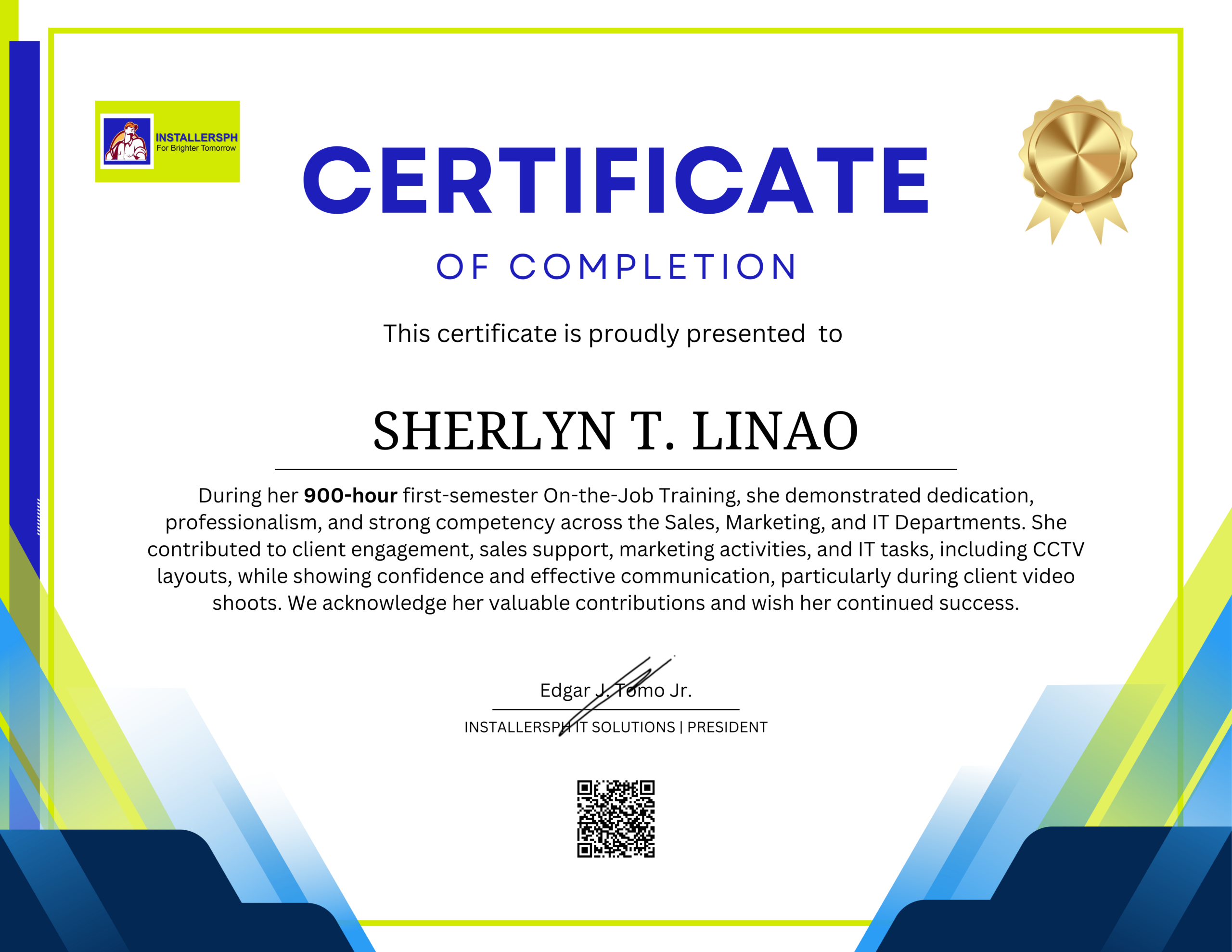Celebrating a Year of Growth and Success at InstallersPH IT Solutions. Introduction. As the year comes to a close, InstallersPH IT Solutions takes a moment to reflect on a journey defined by …
Privacy and Protection: Balancing Security Needs with Residential CCTV Camera Usage.

Introduction
In today’s world, security is a paramount concern for many homeowners. With rising crime rates and increasing awareness of personal safety, the desire to protect one’s home and family has never been greater. As technology advances, residential CCTV (Closed-Circuit Television) cameras have become increasingly popular for enhancing home security. These sophisticated systems offer numerous benefits, such as deterring criminal activity, providing critical evidence in the event of incidents, and ensuring peace of mind for residents. Modern CCTV cameras are equipped with features like high-definition video, night vision, motion detection, and remote monitoring, making them highly effective tools for safeguarding homes.
However, the widespread use of CCTV cameras also raises significant privacy concerns. The ability of these cameras to capture and record continuous footage of both public and private spaces can lead to unintended invasions of privacy. Neighbors, visitors, and even passersby can be recorded without their consent, leading to discomfort and potential legal disputes. Furthermore, the data captured by CCTV systems is susceptible to hacking and misuse, posing risks to personal privacy and security. Balancing the need for security with the right to privacy is a complex issue that requires careful consideration of legal, ethical, and practical factors.
This article explores the intricacies of this balance, providing an in-depth analysis of residential CCTV camera usage, privacy implications, and strategies for achieving harmony between security and privacy. We will delve into the motivations behind the increasing adoption of CCTV cameras, the legal frameworks governing their use, and the ethical dilemmas they present. Additionally, we will discuss best practices for homeowners to ensure their CCTV systems are both effective and respectful of privacy, as well as examine emerging technologies and trends that could shape the future of residential surveillance. Through this comprehensive exploration, we aim to provide a nuanced understanding of how to protect our homes while also safeguarding the privacy rights of individuals.
The Rise of Residential CCTV Cameras
The adoption of residential CCTV cameras has surged in recent years, driven by several factors:
1. Increasing Security Concerns
Homeowners are increasingly concerned about burglary, vandalism, and other criminal activities. CCTV cameras serve as a powerful deterrent, reducing the likelihood of such incidents. In the event of a crime, footage from these cameras can provide valuable evidence to law enforcement.
2. Technological Advancements
Advancements in technology have made CCTV systems more affordable and accessible. Modern cameras offer high-definition video, night vision, and remote monitoring via smartphones and computers. These features enhance the effectiveness of CCTV systems, making them an attractive option for homeowners.
3. Insurance Incentives
Many insurance companies offer discounts on home insurance premiums for properties equipped with CCTV cameras. This financial incentive encourages homeowners to install surveillance systems to protect their assets and reduce insurance costs.
Privacy Concerns and Legal Considerations
While the benefits of residential CCTV cameras are clear, they also pose significant privacy challenges. The following sections explore the primary privacy concerns associated with CCTV usage and the legal frameworks governing their deployment.
1. Invasion of Privacy
CCTV cameras, by their nature, can capture images and videos of individuals without their consent. This raises concerns about the invasion of privacy, particularly in densely populated residential areas. Neighbors, visitors, and passersby may be inadvertently recorded, leading to discomfort and potential legal disputes.
2. Data Security and Misuse
The data captured by CCTV cameras must be stored securely to prevent unauthorized access and misuse. If footage is hacked or improperly handled, it can lead to privacy violations, identity theft, and other malicious activities. Ensuring robust data security measures is crucial to protecting the privacy of individuals recorded by these cameras.
3. Legal Regulations
Different countries and regions have varying legal frameworks governing the use of CCTV cameras. In many places, the law requires homeowners to notify individuals that they are being recorded, typically through visible signage. Additionally, there are often restrictions on where cameras can be placed to avoid infringing on neighbors’ privacy. Understanding and complying with these legal requirements is essential for responsible CCTV usage.
Achieving Balance: Best Practices for Residential CCTV Usage
To balance security needs with privacy concerns, homeowners can adopt several best practices. These practices not only enhance the effectiveness of CCTV systems but also ensure compliance with legal and ethical standards.
1. Conduct a Privacy Impact Assessment
Before installing CCTV cameras, homeowners should conduct a Privacy Impact Assessment (PIA). This process involves evaluating the potential impact of surveillance on individuals’ privacy and identifying measures to mitigate these impacts. A PIA helps ensure that the benefits of CCTV usage outweigh the privacy risks.
2. Limit the Scope of Surveillance
To minimize privacy intrusions, homeowners should carefully consider the placement and field of view of their CCTV cameras. Cameras should be positioned to focus on specific areas of interest, such as entry points, driveways, and other vulnerable spots, rather than capturing broad, indiscriminate footage. Avoid pointing cameras directly at neighbors’ properties or public spaces where there is an expectation of privacy.
3. Inform and Obtain Consent
Transparency is key to balancing security and privacy. Homeowners should inform their neighbors and visitors about the presence of CCTV cameras and, where possible, obtain their consent. Installing clear and visible signage indicating that the area is under surveillance can help achieve this transparency. Communication with neighbors can also prevent potential disputes and foster a cooperative approach to community safety.
4. Implement Robust Data Security Measures
Protecting the data captured by CCTV cameras is critical. Homeowners should use encrypted storage solutions and ensure that only authorized individuals have access to the footage. Regularly updating camera firmware and using strong, unique passwords for system access can further enhance data security. Additionally, setting up alerts for suspicious activities, such as unauthorized login attempts, can help detect and respond to potential security breaches.
5. Establish Data Retention Policies
Determining how long CCTV footage will be retained is an important consideration. Homeowners should establish clear data retention policies, retaining footage only for as long as necessary to achieve its intended purpose. Once the retention period has expired, the data should be securely deleted to reduce the risk of unauthorized access and privacy violations
Ethical Considerations in Residential CCTV Usage
Beyond legal compliance and best practices, ethical considerations play a crucial role in balancing security needs with privacy concerns. Ethical surveillance involves respecting individuals’ rights and ensuring that the use of CCTV cameras is justified and proportionate.
1. Respect for Privacy
Respecting individuals’ privacy is a fundamental ethical principle. Homeowners should avoid using CCTV cameras in a manner that unnecessarily intrudes on private activities. For instance, cameras should not be installed in areas where people have a reasonable expectation of privacy, such as bedrooms, bathrooms, or inside neighbors’ homes. By respecting privacy boundaries, homeowners can build trust within their community and avoid ethical dilemmas.
2. Proportionality and Necessity
The use of CCTV cameras should be proportionate to the security needs they address. Homeowners should evaluate whether the level of surveillance is necessary for the intended purpose and whether less intrusive alternatives could achieve the same result. For example, improving physical security measures, such as installing better locks or lighting, may reduce the need for extensive camera coverage.
3. Accountability and Oversight
Homeowners should be accountable for their CCTV systems and establish mechanisms for oversight. This includes regularly reviewing the use and effectiveness of the cameras, addressing any complaints or concerns raised by neighbors, and being willing to make adjustments if necessary. Accountability ensures that CCTV usage remains justified and respectful of privacy rights.
Technological Innovations and Future Trends
The landscape of residential CCTV usage is continually evolving, with new technologies and trends shaping the way homeowners approach security and privacy. The following sections explore some of these innovations and their potential impact on the balance between security and privacy.
1. Artificial Intelligence and Video Analytics
Artificial Intelligence (AI) and video analytics are transforming CCTV systems by enabling more sophisticated monitoring and analysis. AI-powered cameras can detect unusual activities, recognize faces, and differentiate between humans and animals. These capabilities enhance the effectiveness of surveillance while reducing the need for constant human monitoring. However, the use of AI also raises additional privacy concerns, such as the potential for bias and the implications of facial recognition technology.
2. Integration with Smart Home Systems
CCTV cameras are increasingly being integrated with smart home systems, allowing homeowners to manage security alongside other smart devices. This integration offers greater convenience and control, enabling remote access and real-time alerts. However, it also requires robust cybersecurity measures to protect against hacking and unauthorized access to interconnected devices.
3. Privacy-Enhancing Technologies
To address privacy concerns, new technologies are being developed to enhance privacy protection in CCTV systems. These include features such as automatic redaction of individuals’ faces in footage, privacy masking to blur certain areas of the video, and user-controlled recording options. These innovations help strike a balance by maintaining security while safeguarding individuals’ privacy
Case Studies: Balancing Security and Privacy in Practice
Examining real-world examples can provide valuable insights into how homeowners and communities can effectively balance security needs with privacy concerns. The following case studies illustrate various approaches to achieving this balance.
Case Study 1: Community Surveillance Program
In a suburban neighborhood, residents collaborated to create a community surveillance program aimed at deterring crime and enhancing safety. The program involved installing CCTV cameras at strategic locations, such as entrance and exit points of the neighborhood. To address privacy concerns, the community established clear guidelines for camera placement, ensuring that private properties were not unnecessarily monitored. Additionally, residents were informed about the surveillance program through community meetings and newsletters, fostering transparency and trust. The program successfully reduced crime rates while respecting the privacy of residents.
Case Study 2: Smart Home Security System
A homeowner invested in a smart home security system that included CCTV cameras integrated with other smart devices. The system allowed the homeowner to monitor their property remotely and receive real-time alerts for any suspicious activities. To protect privacy, the homeowner used privacy masking features to obscure areas outside their property, such as neighboring homes and public sidewalks. By combining advanced technology with privacy-conscious practices, the homeowner achieved a high level of security without infringing on others’ privacy.
Case Study 3: Privacy-Conscious Business Owner
A small business owner installed CCTV cameras to enhance the security of their premises. To address potential privacy concerns of employees and customers, the owner implemented several measures. Cameras were placed only in public areas, such as entrances and sales floors, while private areas like restrooms and break rooms were excluded. Clear signage informed everyone about the surveillance, and the owner conducted regular reviews to ensure the cameras were used appropriately. This approach provided security for the business while respecting the privacy of individuals.
Conclusion
Balancing security needs with privacy concerns in residential CCTV camera usage is a multifaceted challenge that requires careful consideration of legal, ethical, and practical factors. By adopting best practices, respecting privacy rights, and leveraging technological innovations, homeowners can effectively enhance their security while protecting the privacy of individuals. Achieving this balance not only improves safety but also fosters trust and cooperation within communities. As technology continues to evolve, ongoing dialogue and adaptation will be essential to ensure that residential CCTV usage remains both effective and respectful of privacy.
Related Articles
Notice to the Public: Holiday Vacation Advisory of InstallersPH IT Solutions. Introduction. InstallersPH IT Solutions is committed to providing reliable and professional IT services to all our valued clients and partners. As …
The On-the-Job Training Experience of Sherlyn Linao. Introduction On-the-Job Training (OJT) is an essential part of a student’s academic development, providing practical exposure to real workplace environments. It allows interns to apply …



